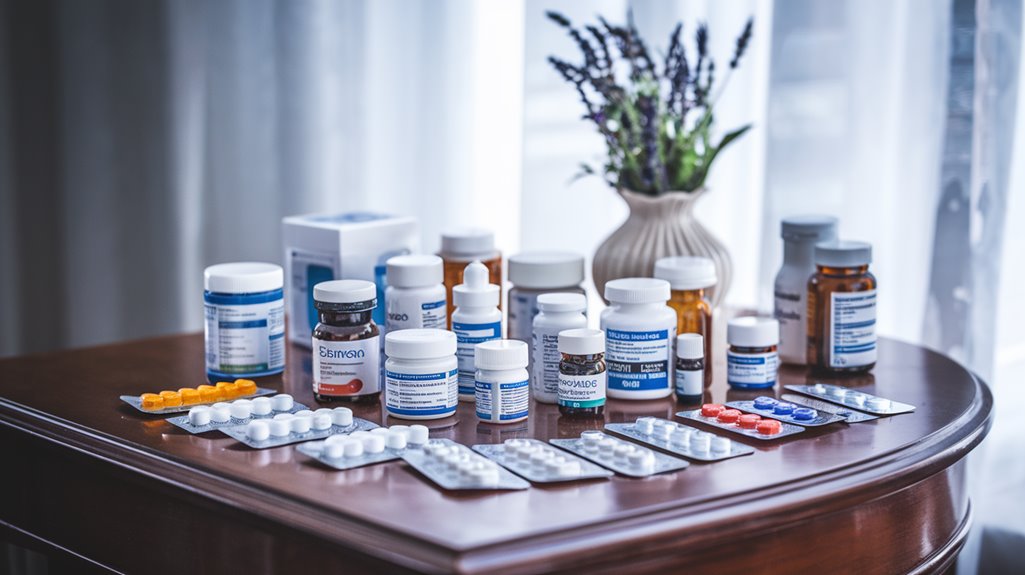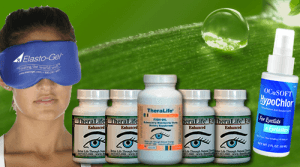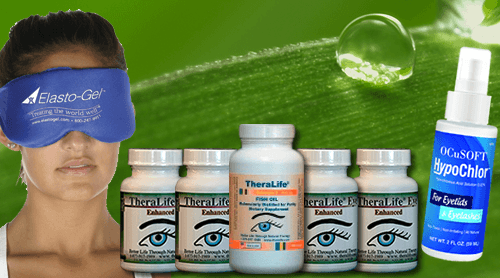TheraLife offers products that benefit customers by addressing various eye-related conditions with a focus on natural and holistic remedies. Their approach to managing Sjögren’s syndrome, in particular, involves non-drug therapies that aim to enhance overall eye health and function. For instance, they provide solutions that help alleviate symptoms like dry eyes, blepharitis, and uveitis. TheraLife targets the root causes of these conditions, offering relief without the side effects often associated with conventional medications.
For example, TheraLife’s products are designed to increase natural tear production, which can be beneficial for those experiencing dry eyes due to Sjögren’s. They also emphasize the importance of an anti-inflammatory diet, which can aid in reducing systemic inflammation and improving eye health. Additionally, TheraLife provides guidance on avoiding environmental triggers and selecting appropriate eye makeup to minimize irritation and further discomfort.
Ultimately, TheraLife’s focus on natural and integrative treatment strategies offers customers a comprehensive plan to manage their symptoms effectively, enhancing their quality of life while minimizing dependency on pharmaceuticals.
All Natural Dry Eye, Joint Relief For Sjogren’s – No Steroids
Add To Cart
Reduce inflammation, manage Sjogren’s with all natural products that work.
Key Takeaways
- Corticosteroids provide rapid relief by modulating inflammatory pathways, essential for acute symptom control in Sjögren’s syndrome.
- NSAIDs effectively reduce joint pain and inflammation, serving as accessible first-line treatment for mild symptoms.
- Hydroxychloroquine is the primary systemic medication, offering long-term control with an established safety profile in autoimmune conditions.
- Biological therapies like rituximab target B-cell hyperactivity, managing severe organ manifestations and reducing cytokine-mediated inflammation.
- Emerging treatments, including muscarinic agonists and neurostimulation, enhance symptom management and are crucial for comprehensive care.
Corticosteroids for Rapid Relief
Although corticosteroids offer rapid relief for those with Sjögren’s syndrome experiencing severe symptoms or flares, their use demands careful consideration due to a broad spectrum of potential side effects. Understanding corticosteroid mechanisms is essential; these agents modulate inflammatory pathways, providing swift symptomatic palliation. Clinicians often employ dosage strategies where short-term administration suffices, curtailing potential complications. Initial high doses may be required for acute control, with subsequent tapering to mitigate adverse effects like hypertension or osteoporosis. For chronic inflammation, systemic and topical applications are tailored, optimizing therapeutic outcomes while minimizing risk. Sjögren’s syndrome can be complicated by overlapping symptoms with other conditions such as lupus and rheumatoid arthritis, necessitating a careful and comprehensive treatment approach. Combination of management strategies often required ensures that corticosteroids are used effectively alongside other treatments to manage the disease holistically. A steroid-sparing approach, integrating adjunctive therapies, may further reduce corticosteroid burden, thereby enhancing patient safety. As a result, precise dosage management remains pivotal in balancing efficacy and tolerability.
NSAIDs for Pain Management
You’re likely aware that NSAIDs, by inhibiting cyclooxygenase enzymes, effectively reduce prostaglandin synthesis, thereby mitigating inflammation and providing analgesia in Sjögren’s syndrome. NSAIDs are often combined with immunosuppressive medications to enhance their effectiveness in managing joint pain associated with the condition. As a first-line pharmacologic strategy, NSAIDs are frequently employed due to their dual action on pain and inflammation, but their application necessitates a rigorous assessment of risk-benefit ratios, particularly concerning gastrointestinal, renal, and cardiovascular safety profiles. Incorporating NSAIDs into a treatment regimen demands careful consideration of patient-specific factors, ensuring efficacy while minimizing adverse effects through vigilant monitoring and dosage optimization. For individuals with Sjögren’s syndrome, an autoimmune diet can complement NSAIDs by addressing underlying inflammation, potentially improving overall symptom management.
Inflammation and Pain Relief
When managing the symptoms of Sjögren’s syndrome, NSAIDs play an essential role in controlling inflammation and providing pain relief. These agents, including ibuprofen, naproxen, and diclofenac, exhibit NSAID effectiveness by inhibiting cyclooxygenase enzymes, thereby reducing prostaglandin synthesis—key mediators in inflammation mechanisms. This biochemical interruption minimizes inflammatory responses and alleviates joint pain and discomfort. Administered orally or topically, NSAIDs offer versatile options for targeted pain management. However, long-term use necessitates caution, given potential gastrointestinal, cardiovascular, and renal side effects. Individuals with Sjögren’s syndrome may also experience dry eyes and mouth due to the autoimmune nature of the condition. Monitoring and dosage adjustments are important to mitigate risks such as stomach upset and ulcers. Additionally, conditions like keratoconjunctivitis sicca, commonly associated with autoimmune diseases like RA, highlight the need for comprehensive eye care in Sjögren’s patients. Effective as adjunctive therapies, NSAIDs can enhance the symptom-modulating effects of other pharmacologic interventions, ensuring a thorough approach to managing Sjögren’s syndrome.
First-line Treatment Strategy
In managing Sjögren’s syndrome, NSAIDs serve as a cornerstone for first-line treatment of joint pain, leveraging their ability to inhibit cyclooxygenase enzymes and consequently impede prostaglandin synthesis. Commonly prescribed agents like ibuprofen and naproxen offer efficacious, albeit temporary, analgesic benefits. Patient adherence is pivotal, as therapeutic outcomes correlate with consistent NSAID intake. Treatment accessibility is enhanced by the over-the-counter availability for mild symptoms, while prescription-strength options cater to persistent pain. These NSAIDs can be used in conjunction with immunosuppressant drugs like methotrexate to manage more severe cases. Patients with Sjögren’s syndrome and lupus might experience extreme fatigue, which can affect medication adherence and overall quality of life. Regular monitoring and dose optimization are critical to mitigate gastrointestinal and cardiovascular risks.
Safety and Efficacy
Building on the foundational role of NSAIDs in managing Sjögren’s syndrome, evaluating their safety and efficacy is essential for ideal patient outcomes. NSAIDs effectively reduce inflammation and pain by inhibiting prostaglandins, vital in chronic Sjögren’s pain management. However, long-term safety concerns arise, including gastrointestinal bleeding, kidney disease, and cardiovascular risks. Diclofenac, for instance, can reduce corneal sensitivity, necessitating caution. Patients with Sjögren’s syndrome often experience musculoskeletal pain, which NSAIDs help to alleviate by addressing the inflammation underlying this symptom. Regular monitoring for side effects, such as gastrointestinal issues, is important. NSAID alternatives, like Cox-2 inhibitors, may offer reduced gastrointestinal risks but require consideration of other adverse effects. Compared to opioids, NSAIDs present fewer short-term adverse events, yet careful management of dosing and duration remains key to minimize complications and optimize therapeutic efficacy. The AIP diet may provide additional symptom relief by reducing inflammation through dietary changes, particularly for autoimmune conditions like Sjögren’s syndrome.
Hydroxychloroquine for Long-Term Control
Despite the limited data supporting its use, Hydroxychloroquine (HCQ) remains the primary systemic medication for managing Sjögren’s syndrome due to its established safety profile in rheumatologic conditions like systemic lupus erythematosus (SLE).
Patient experiences underscore HCQ’s role in ameliorating systemic disease activity, though outcomes vary. Dosing strategies are essential, as titration is often necessary to mitigate side effects such as gastrointestinal disturbances and neurological symptoms. Importantly, early treatment with HCQ is linked to better outcomes in rheumatology, emphasizing the necessity of initiating therapy as soon as possible. TheraLife’s approach to immune modulation complements HCQ therapy by focusing on long-term health improvement and reducing inflammation associated with Sjögren’s syndrome.
Clinical studies, including a small Japanese trial, demonstrated HCQ’s efficacy at reducing EULAR Sjögren’s syndrome disease activity index (ESSDAI) scores and IgG levels.
However, the JOQUER trial‘s premature cessation accentuates the need for prolonged research to fully elucidate HCQ’s potential in long-term disease modulation and symptomatology stabilization.
Biological Therapies for Severe Cases
For severe organ manifestations of Sjögren’s syndrome, biological therapies like rituximab and tocilizumab target B-cell hyperactivity and cytokine-mediated inflammation, offering potential for enhanced long-term disease control. Rituximab depletes pathological B-cells, addressing keratoconjunctivitis sicca and systemic vasculitis, while tocilizumab inhibits IL-6, mitigating pro-inflammatory cascades. These interventions necessitate vigilant monitoring for adverse events, yet they provide a strategic advantage in managing refractory cases unresponsive to traditional therapies. The high prevalence of Sjögren’s syndrome, affecting approximately 4 million people in the U.S., underscores the urgent need for effective treatments like biological therapies. As there are no disease-modifying drugs specifically approved for pSS, these biological therapies represent a significant advancement in addressing the underlying pathophysiological mechanisms of the disease.
Targeting Severe Organ Manifestations
In targeting severe organ manifestations of Sjögren’s syndrome, biological therapies play an essential role in managing the complex immunological landscape of the disease. Targeted therapies like rituximab and abatacept are pivotal in addressing organ involvement, particularly in advanced stages. Rituximab’s efficacy lies in depleting CD20+ B cells, thereby reducing lymphocytic infiltration and improving salivary gland architecture. Abatacept, by inhibiting T-cell co-stimulation, mitigates inflammation, offering relief in early disease stages. For extraglandular symptoms, belimumab provides an option, while cyclophosphamide and azathioprine target severe organ involvement such as renal or pulmonary manifestations. Biological therapies, despite their effectiveness, often face challenges like high costs and access constraints, emphasizing the need for careful consideration in clinical practice. In autoimmune disorders like rheumatoid arthritis, biologic therapies target specific components of the immune system to manage symptoms effectively.
Enhancing Long-term Disease Control
When managing severe cases of Sjögren’s Syndrome, enhancing long-term disease control with biological therapies is essential. Biologic advancements focus on cytokine inhibition to mitigate glandular damage and systemic inflammation. B-cell targeted agents, such as rituximab and belimumab, modulate immune response by altering B-cell activity, vital in disease pathogenesis. Recently, research has highlighted the potential of neurostimulation as an innovative treatment approach to alleviate dry eyes and mouth symptoms. Gene therapy represents an innovative frontier, aiming to restore salivary function through therapeutic gene delivery. Personalized medicine strategies tailor interventions to the patient’s specific immune profile, optimizing therapeutic outcomes. Emerging evidence from clinical trials underscores cytokine inhibitors’ efficacy, while personalized treatment plans adapt to disease progression stages. Patients using cevimeline may experience increased salivary flow, highlighting its supportive role in managing dry mouth symptoms. As research evolves, precision medicine promises to refine biologic applications, enhancing efficacy and safety for individualized disease management.
Muscarinic Agonists for Dry Mouth
Muscarinic agonists, like pilocarpine and cevimeline, are pivotal in managing xerostomia in Sjögren’s syndrome by greatly enhancing salivary flow. Through muscarinic mechanisms, these agents effectively stimulate the salivary glands, mimicking acetylcholine, leading to significant salivary stimulation. Pilocarpine, particularly Salagen, and cevimeline, known as Evoxac, are FDA-approved, demonstrating clinical efficacy in ameliorating dry mouth symptoms. Pilocarpine requires frequent dosing, three to four times daily, to maintain its therapeutic effect. Cevimeline, on the other hand, provides statistically significant improvements with a generally favorable safety profile. Cevimeline, specifically, shows a 40-fold greater affinity for the M3 receptor compared to the M2 cardiac receptor, which contributes to its effectiveness in treating xerostomia in Sjögren syndrome. High-quality evidence supports their superiority over placebo. They reduce reliance on artificial saliva with consistent use. Expected side effects align with muscarinic action. Optimal for patients when other treatments are insufficient.
Exploring New Treatment Options
As the medical community explores advanced therapies for Sjögren’s Syndrome, a multifaceted approach emerges, targeting multiple biological pathways.
Neurostimulation therapies are being investigated to modulate neural circuits controlling exocrine gland function, potentially alleviating xerostomia and keratoconjunctivitis sicca. This innovative modality, though in nascent stages, holds therapeutic potential contingent upon rigorous safety and efficacy evaluations.
Concurrently, gene therapy advancements aim to transduce salivary glandular tissue with vectors encoding moisture-promoting genes, offering a paradigm shift in localized treatment strategies.
These emerging avenues underscore a paradigm shift towards precision medicine, leveraging molecular and genetic insights to refine treatment algorithms.
As these modalities advance, they promise to augment the therapeutic armamentarium against Sjögren’s, enhancing patient outcomes and quality of life.
Clinical Considerations and Monitoring
While new treatment avenues like neurostimulation and gene therapy hold promise, clinical considerations and monitoring remain integral to managing Sjögren’s Syndrome effectively.
You must engage in regular clinical monitoring to tailor medication adjustments, ensuring ideal therapeutic outcomes. Patients require periodic evaluations every 3-6 months, focusing on symptomatology and potential adverse effects. Blood counts and liver enzyme tests are critical for those on immunosuppressants, mitigating the risk of organ damage. Eye exams are essential for hydroxychloroquine users to prevent retinal toxicity.
- Regularly evaluate systemic involvement and adjust medications accordingly.
- Employ a multidisciplinary approach, involving dentists and eye care specialists.
- Weigh the benefits of NSAIDs against gastrointestinal risks.
- Prioritize corticosteroid minimization to reduce side effect burdens.
Frequently Asked Questions
How Do Lifestyle Changes Impact Sjögren’s Treatment Effectiveness?
You enhance Sjögren’s treatment effectiveness by implementing lifestyle adjustments that complement pharmacological interventions.
Dietary adaptations, like increasing omega-3 intake and antioxidant-rich foods, can modulate inflammatory pathways.
Physical activity improves immune function and mitigates fatigue.
Consistent sleep optimizes cytokine production, promoting systemic homeostasis.
Treatment adherence is bolstered by these holistic approaches, ensuring extensive management.
Engaging with healthcare providers refines personalized plans, synchronizing lifestyle changes with prescribed therapies for maximal therapeutic efficacy.
Can Diet Modifications Aid in Managing Sjögren’s Symptoms?
You can greatly manage Sjögren’s symptoms by implementing dietary restrictions.
Increasing omega-3 fatty acids through specific fish and oils may promote anti-inflammatory pathways and enhance immune modulation.
Prioritizing whole, unprocessed foods retains bioactive compounds, reducing pro-inflammatory cytokine production.
Avoiding gluten, refined sugars, and caffeine is essential as these can exacerbate systemic inflammation and glandular dysfunction.
Clinical evidence supports these dietary modifications for symptom relief and overall disease management.
Are There Any Natural Remedies Beneficial for Sjögren’s Patients?
Imagine 90% of Sjögren’s patients experience relief with herbal supplements. You might explore homeopathy options, which can offer adjunctive benefits.
Omega-3 supplements, proven to modulate inflammatory cytokines, could enhance ocular surface homeostasis. Probiotics may improve gut microbiota, influencing systemic immunomodulation.
Vitamin C aids in collagen synthesis, potentially enhancing salivary gland function. Evidence suggests herbal teas can provide temporary symptomatic relief by increasing mucosal hydration, consequently supporting holistic management strategies.
How Does Stress Influence Sjögren’s Disease Progression?
Stress markedly influences Sjögren’s disease progression by exacerbating symptoms through neuroendocrine-immune interactions.
You should prioritize stress management to mitigate these effects. Chronic stress correlates with increased disease activity, necessitating interventions targeting emotional health.
Implementing cognitive-behavioral strategies, mindfulness, and relaxation techniques can optimize autonomic functions, subsequently reducing inflammatory mediators.
What Role Does Exercise Play in Alleviating Sjögren’s Symptoms?
Exercise benefits in Sjögren’s syndrome manifest through enhanced cardiovascular fitness and reduced fatigue. Engaging in regular physical activity, like aerobic exercises, increases VO2max and cardiorespiratory efficiency without exacerbating disease activity.
Supervised walking programs significantly mitigate fatigue and improve quality of life parameters, including mental health aspects. Adherence to such regimens remains high, with exercise showing no adverse impact on inflammation markers or disease progression, offering a safe, effective intervention.
Conclusion
In managing Sjogren’s, it’s important to consider the benefits of TheraLife’s products for optimal care. TheraLife offers a holistic approach with natural, effective solutions specifically designed to alleviate symptoms associated with Sjogren’s and other eye conditions. Their products, such as the TheraLife Eye Enhanced, are formulated to reduce inflammation, improve tear production, and provide relief from dry eyes and associated discomfort.
TheraLife’s focus on natural ingredients and evidence-based solutions ensures that customers receive treatments that are both safe and effective. For those suffering from conditions like blepharitis, dry eyes, and Sjogren’s syndrome, TheraLife’s comprehensive product line offers targeted relief, enhancing overall eye health and quality of life.
In addition to their products, TheraLife provides valuable resources and guidance on lifestyle modifications and dietary changes to further support eye health. By integrating these natural treatments and expert advice, TheraLife empowers customers to manage their symptoms effectively and sustain long-term eye wellness.
References
- 1.
- Kaneko Y. [Diagnostic (Classification) Criteria and Treatment Guidelines of Collagen-vascular Diseases: Hos to Use and Cautions on Applying Them for General Physicians. Topics: VII. Sjögren Syndrome]. Nihon Naika Gakkai Zasshi. 2015 Oct;104(10):2149-56. [PubMed]
- 2.
- Brito-Zerón P, Retamozo S, Ramos-Casals M. Phenotyping Sjögren’s syndrome: towards a personalised management of the disease. Clin Exp Rheumatol. 2018 May-Jun;36 Suppl 112(3):198-209. [PubMed]
- 3.
- Argyropoulou OD, Valentini E, Ferro F, Leone MC, Cafaro G, Bartoloni E, Baldini C. One year in review 2018: Sjögren’s syndrome. Clin Exp Rheumatol. 2018 May-Jun;36 Suppl 112(3):14-26. [PubMed]
- 4.
- Baer AN, Akpek EK, Alevizos I., 18-21 April 2018, Washington, DC, USA. 14th International Symposium on Sjögren’s Syndrome. Clin Exp Rheumatol. 2018 May-Jun;36 Suppl 112(3):241-255. [PubMed]
- 5.
- Kroese FGM, Haacke EA, Bombardieri M. The role of salivary gland histopathology in primary Sjögren’s syndrome: promises and pitfalls. Clin Exp Rheumatol. 2018 May-Jun;36 Suppl 112(3):222-233. [PubMed]
- 6.
- Kiadaliri AA, Mohammad AJ, Englund M. Hospitalizations due to systemic connective tissue diseases: Secular trends and regional disparities in Sweden, 1998-2016. Int J Rheum Dis. 2018 Nov;21(11):1900-1906. [PubMed]
- 7.
- Alani H, Henty JR, Thompson NL, Jury E, Ciurtin C. Systematic review and meta-analysis of the epidemiology of polyautoimmunity in Sjögren’s syndrome (secondary Sjögren’s syndrome) focusing on autoimmune rheumatic diseases. Scand J Rheumatol. 2018 Mar;47(2):141-154. [PubMed]
- 8.
- Bunya VY, Fernandez KB, Ying GS, Massaro-Giordano M, Macchi I, Sulewski ME, Hammersmith KM, Nagra PK, Rapuano CJ, Orlin SE. Survey of Ophthalmologists Regarding Practice Patterns for Dry Eye and Sjogren Syndrome. Eye Contact Lens. 2018 Nov;44 Suppl 2(Suppl 2):S196-S201. [PMC free article] [PubMed]
- 9.
- Tzioufas AG, Goules AV. Limited efficacy of targeted treatments in Sjögren’s syndrome: why? Clin Exp Rheumatol. 2018 May-Jun;36 Suppl 112(3):27-28. [PubMed]
- 10.
- De Vita S, Gandolfo S, Zandonella Callegher S, Zabotti A, Quartuccio L. The evaluation of disease activity in Sjögren’s syndrome based on the degree of MALT involvement: glandular swelling and cryoglobulinaemia compared to ESSDAI in a cohort study. Clin Exp Rheumatol. 2018 May-Jun;36 Suppl 112(3):150-156. [PubMed]
- 11.
- Martel A, Coiffier G, Bleuzen A, Goasguen J, de Bandt M, Deligny C, Magnant J, Ferreira N, Diot E, Perdriger A, Maillot F. What is the best salivary gland ultrasonography scoring methods for the diagnosis of primary or secondary Sjögren’s syndromes? Joint Bone Spine. 2019 Mar;86(2):211-217. [PubMed]
- 12.
- Baer AN, Walitt B. Update on Sjögren Syndrome and Other Causes of Sicca in Older Adults. Rheum Dis Clin North Am. 2018 Aug;44(3):419-436. [PMC free article] [PubMed]
- 13.
- Sumida T, Azuma N, Moriyama M, Takahashi H, Asashima H, Honda F, Abe S, Ono Y, Hirota T, Hirata S, Tanaka Y, Shimizu T, Nakamura H, Kawakami A, Sano H, Ogawa Y, Tsubota K, Ryo K, Saito I, Tanaka A, Nakamura S, Takamura E, Tanaka M, Suzuki K, Takeuchi T, Yamakawa N, Mimori T, Ohta A, Nishiyama S, Yoshihara T, Suzuki Y, Kawano M, Tomiita M, Tsuboi H. Clinical practice guideline for Sjögren’s syndrome 2017. Mod Rheumatol. 2018 May;28(3):383-408. [PubMed]
- 14.
- Seror R, Mariette X. Guidelines for treatment of primary Sjögren’s syndrome: a first useful stone but still much to do. Rheumatology (Oxford). 2017 Oct 01;56(10):1641-1642. [PubMed]
- 15.
- Price EJ, Rauz S, Tappuni AR, Sutcliffe N, Hackett KL, Barone F, Granata G, Ng WF, Fisher BA, Bombardieri M, Astorri E, Empson B, Larkin G, Crampton B, Bowman SJ., British Society for Rheumatology Standards, Guideline and Audit Working Group. The British Society for Rheumatology guideline for the management of adults with primary Sjögren’s Syndrome. Rheumatology (Oxford). 2017 Oct 01;56(10):e24-e48. [PubMed]
- 16.
- López-Pintor RM, Fernández Castro M, Hernández G. Oral involvement in patients with primary Sjögren’s syndrome. Multidisciplinary care by dentists and rheumatologists. Reumatol Clin. 2015 Nov-Dec;11(6):387-94. [PubMed]
- 17.
- Brito-Zerón P, Theander E, Baldini C, Seror R, Retamozo S, Quartuccio L, Bootsma H, Bowman SJ, Dörner T, Gottenberg JE, Mariette X, Bombardieri S, de Vita S, Mandl T, Ng WF, Kruize AA, Tzioufas A, Vitali C, Buyon J, Izmirly P, Fox R, Ramos-Casals M., Eular Sjögren Syndrome Task Force. Early diagnosis of primary Sjögren’s syndrome: EULAR-SS task force clinical recommendations. Expert Rev Clin Immunol. 2016;12(2):137-56. [PubMed]
- 18.
- Milin M, Cornec D, Chastaing M, Griner V, Berrouiguet S, Nowak E, Marhadour T, Saraux A, Devauchelle-Pensec V. Sicca symptoms are associated with similar fatigue, anxiety, depression, and quality-of-life impairments in patients with and without primary Sjögren’s syndrome. Joint Bone Spine. 2016 Dec;83(6):681-685. [PubMed]
- 19.
- Flores-Chávez A, Kostov B, Solans R, Fraile G, Maure B, Feijoo-Massó C, Rascón FJ, Pérez-Alvarez R, Zamora-Pasadas M, García-Pérez A, Lopez-Dupla M, Duarte-Millán MÁ, Ripoll M, Fonseca-Aizpuru E, Guisado-Vasco P, Pinilla B, de-la-Red G, Chamorro AJ, Morcillo C, Fanlo P, Soto-Cárdenas MJ, Retamozo S, Ramos-Casals M, Brito-Zerón P., GEAS-SS SEMI Registry. Severe, life-threatening phenotype of primary Sjögren’s syndrome: clinical characterisation and outcomes in 1580 patients (GEAS-SS Registry). Clin Exp Rheumatol. 2018 May-Jun;36 Suppl 112(3):121-129. [PubMed]
- 20.
- Al Hamad A, Lodi G, Porter S, Fedele S, Mercadante V. Interventions for dry mouth and hyposalivation in Sjögren’s syndrome: A systematic review and meta-analysis. Oral Dis. 2019 May;25(4):1027-1047. [PubMed]
- 21.
- Björk A, Mofors J, Wahren-Herlenius M. Environmental factors in the pathogenesis of primary Sjögren’s syndrome. J Intern Med. 2020 May;287(5):475-492. [PubMed]
- 22.
- Lessard CJ, Li H, Adrianto I, Ice JA, Rasmussen A, Grundahl KM, Kelly JA, Dozmorov MG, Miceli-Richard C, Bowman S, Lester S, Eriksson P, Eloranta ML, Brun JG, Gøransson LG, Harboe E, Guthridge JM, Kaufman KM, Kvarnström M, Jazebi H, Cunninghame Graham DS, Grandits ME, Nazmul-Hossain AN, Patel K, Adler AJ, Maier-Moore JS, Farris AD, Brennan MT, Lessard JA, Chodosh J, Gopalakrishnan R, Hefner KS, Houston GD, Huang AJ, Hughes PJ, Lewis DM, Radfar L, Rohrer MD, Stone DU, Wren JD, Vyse TJ, Gaffney PM, James JA, Omdal R, Wahren-Herlenius M, Illei GG, Witte T, Jonsson R, Rischmueller M, Rönnblom L, Nordmark G, Ng WF, UK Primary Sjögren’s Syndrome Registry. Mariette X, Anaya JM, Rhodus NL, Segal BM, Scofield RH, Montgomery CG, Harley JB, Sivils KL. Variants at multiple loci implicated in both innate and adaptive immune responses are associated with Sjögren’s syndrome. Nat Genet. 2013 Nov;45(11):1284-92. [PMC free article] [PubMed]
- 23.
- Baldini C, Fulvio G, La Rocca G, Ferro F. Update on the pathophysiology and treatment of primary Sjögren syndrome. Nat Rev Rheumatol. 2024 Aug;20(8):473-491. [PubMed]





